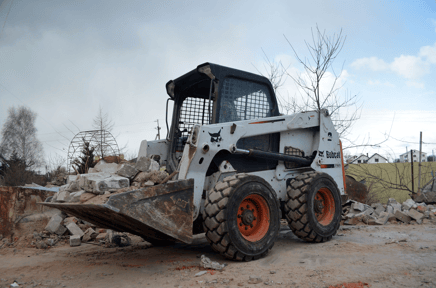Telematics are an invaluable addition to any equipment fleet,
including compact equipment like skid steers, compact excavators, dump trucks, and even company vehicles. Here are a few ways that telematics platforms are proving their worth to this important industry segment.

Theft Recovery and Prevention
The portability of compact equipment makes it more susceptible to theft, and telematics can help to prevent theft as well as recover stolen goods. It is important to know where equipment is at any given time – but knowing how it got there can also be valuable information. Just ask the team at Weaver Brothers Construction. This New Hampshire contractor purchased a new skid steer and outfitted it with telematics. Shortly afterward, they arrived at the job site Monday morning and learned that the skid steer was not where they had placed it the previous Friday. Checking the telematics breadcrumb trail, they discovered that on Saturday, the skid steer took a ride an hour away without them knowing. Fortunately, the people at Weaver were able to track down the skid steer and found it in good condition, although the forks were missing.
Another look at the breadcrumb trail showed a four-minute stop on a side street during the Saturday excursion. Upon checking the area, they found another skid steer with the missing forks on it. The company reported an easy recovery of the equipment, although the forks were held as evidence. Shop Supervisor Tony Salera summed up the situation succinctly, “We were lucky. A $100k machine returned to work within 4 hours of realizing it was gone.”
After recovering the equipment, the company set up text alerts for any machines turned on after hours. Should another brazen thief try to sneak equipment off a job site, the Weaver team would be notified when the equipment is started.
Jon M Hall company uses that functionality to safeguard their equipment stored in remote job sites. Expensive equipment like lasers, small, powered equipment, tools, copper wire and pipe, and more are stored in Conex Boxes. A circuit is installed including a telematics unit with “starter disable” activated, a 12-volt battery with solar panel charger, a door circuit switch, a motion detector, and a police siren. When the door is opened after hours, or motion is detected, the positive circuit is completed which starts the siren wailing. With some ingenuity and a thorough understanding of telematics features, Jon M Hall’s equipment and supplies are safeguarded in remote locations.
Better Utilization of Equipment Reduces Rentals
Hopefully tracking down stolen equipment is a rarity for contractors, but knowing where equipment is, and how often it is being used is a daily event. OEM telematics provides machine-level data such as when equipment is due for maintenance, while third-party telematics provides fleet-level data such as where equipment is, and how often it is used. Companies can use this information to position the right equipment to the right job sites at the right time – thus keeping projects on track and on budget. Scotty’s Contracting & Stone has been completing heavy civil and paving projects from Louisville to Nashville for over 50 years. Equipment utilization was much easier when the company had only 12-grade jobs on any given day – with 70-grade jobs occurring simultaneously utilization gets a lot more complicated.
Vice President of Engineering and Construction Chris Higgins leverages utilization stats from his telematics platform over the last seven to 30 days, to see which machines are being used and which ones aren’t. “Everybody wants all the equipment on their job, but they might not necessarily have a current need for them,” Higgins explained. While a project foreman or manager may feel like they just used a piece of equipment, the data lets Scotty’s see actual utilization. “It’s easy to spot underutilized equipment because I can look right away and tell if it’s not being used so I can take it somewhere else instead.”
For Scotty’s foremen, the data has turned into an ongoing contest. “Our foremen look at utilization and compare themselves or compete with each other internally, which is fun to see,” Higgins said.
This friendly competition not only helps Scotty’s increase their efficiency but also save money in costly equipment rentals that run from hundreds to thousands of dollars per day depending on the equipment. “Today was the day for mini excavators. Tomorrow, it may be dozers,” Higgins explained of the shifting needs of the industry.
Improve What You Measure – Even Driving Habits
Driver safety is a concern for virtually any company that has vehicles on the road. In addition to the conduct of the drivers themselves, and interactions with those around them, there is the concern of how bad driver behavior might be perceived by the public. One Georgia contractor is using telematics to rein in driver behavior, to reduce incidents of speeding (relative to the posted speed limit), hard braking, fast starts, and hard turns among their fleet of 150 on-road vehicles.
Vehicle data is captured from either the telematics App (primarily for third-party drivers) or from an in-vehicle device (for all company vehicles).
This data, which is reported continuously, is used to assign a numeric score and a letter grade to each driver. The telematics platform tabulates the data into a report which is distributed to the key company personnel weekly. Armed with the report, the president identifies the most egregious offenders and alerts their supervisors who then have a chat with the bad drivers.
The Business Process Manager recalls one driver who had earned an F one week. “So, we had a serious talk with him. The next week he went from an F to an A-, so we had a lighter talk with him. ‘You did great last week, we’re all proud of you, keep it up.” Rather than just saying “You have to do better” the company talked about the responsibility associated with driving. They also gave him tips based on the habits that the telematics showed – such as leaving more space than he normally does to give ample brake distance to avoid Harsh Braking events shown by the telematics platform. Ultimately his scores stayed within the B range.
“We may not have ever known about this driver’s habits without using telematics.” Using Telematics To Eliminate Idle Reducing the time that equipment is idling benefits owners of compact equipment by reducing unnecessary fuel consumption, elongating service life, and saving on depreciation and maintenance costs. Escalating idle alerts, which notify supervisors when equipment is running un-productively, are a key element to reducing equipment. Users set the timeframe for acceptable idle, then when a machine exceeds that time, the supervisor gets a text message or email. If the machine continues to idle for another set time, the supervisor gets another notification, as does his boss. If a third notification is required, someone higher in the organization is notified. Equipment is usually put to work or shut down quickly. This feature can also be included on company vehicles.
Third-party telematics benefits all classes of equipment users, including compact equipment. Unlocking the value within the data allows contractors to better plan their projects, complete projects more efficiently, eliminate idle and eliminate rental costs through better utilization. Telematics also helps users to prevent theft of equipment, quickly find stolen equipment, and improve driver behavior. As technology continues to evolve and add functionalities, contractors and compact equipment users will discover new ways to improve their operations through telematics.


